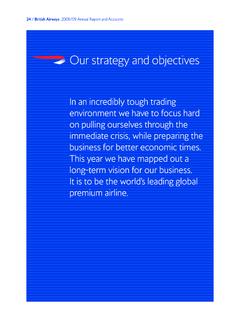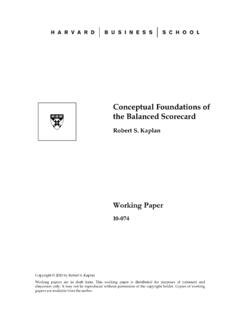Transcription of evaluation business strategy rumelt
1 1 THE evaluation OF business strategy * BY RICHARD rumelt strategy can neither be formulated nor adjusted to changing circumstances without a process of strategy evaluation . Whether performed by an individual or as part of an organizational review procedure, strategy evaluation forms an essential step in the process of guiding an enterprise. For many executives strategy evaluation is simply an appraisal of how well a business performs. Has it grown? Is the profit rate normal or better? If the answers to these questions are affirmative, it is argued that the firm s strategy must be sound. Despite its unassailable simplicity, this line of reasoning misses the whole point of strategy -that the critical factors determining the quality of current results are often not directly observable or simply measured, and that by the time strategic opportunities or threats do directly affect operating results, it may well be too late for an effective response. Thus, strategy evaluation is an attempt to look beyond the obvious facts regarding the short-term health of a business and appraise instead those more fundamental factors and trends that govern success in the chosen field of endeavor.
2 THE CHALLENGE OF evaluation However it is accomplished, the products of a business strategy evaluation are answers to these three questions: 1. Are the objectives of the business appropriate? 2. Are the major policies and plans appropriate? 3. Do the results obtained to date confirm or refute critical assumptions on which the strategy rests? Devising adequate answers to these questions is neither simple nor straightforward. It requires a reasonable store of situation-based knowledge and more than the usual degree of insight. In particular, the major issues which make evaluation difficult and with which the analyst must come to grips are these: Each business strategy is unique. For example, one paper manufacturer might rely on -its vast timber holdings to weather almost any storm while another might place primary reliance in modern machinery and an extensive distribution system. Neither strategy is "wrong" nor "night" in any absolute sense; both may be night or wrong for the firms in question.
3 strategy evaluation must, then, rest on a type of situational logic that does not focus on "one best way" but which can be tailored to each problem as it is faced. strategy is centrally concerned with the selection of goals and objectives . Many people, including seasoned executives, find it much easier to set or try to achieve goals than to evaluate them. In part this is a consequence of training in problem structuring. It also arises out of a * 2 tendency to confuse values, which are fundamental expressions of human personality, with objectives , which are devices for lending coherence to action. Formal systems of strategic review, while appealing in principle, can create explosive conflict situations. Not only are there serious questions as to who is qualified to give an objective evaluation , the whole idea of strategy evaluation implies management by "much more than results" and runs counter to much of currently popular management philosophy.
4 THE PRINCIPLES OF strategy evaluation .. For our purposes a strategy is a set of objectives , policies, and plans that, taken together, define the scope of the enterprise and its approach to survival and success. Alternatively, we could say that the particular policies, plans, and objectives of a business express its strategy for coping with a complex competitive environment. One of the fundamental tenets of science is that a theory can never be proven to be absolutely true. A theory can, however, be declared absolutely false if it fails to stand up to testing. Similarly, it is impossible to demonstrate conclusively that a Particular business strategy is optimal or even to guarantee that it will work. One can, nevertheless, test it for critical flaws. Of the many tests which could be justifiably applied to a business strategy , most will fit within one of these broad criteria: Consistency: The strategy must not present mutually inconsistent goals and policies.
5 Consonance: The strategy must represent an adaptive response to the external environment and to the critical changes occurring within it. Advantage: The strategy must provide for the creation and/or maintenance of a competitive advantage in the selected area of activity. Feasibility: The strategy must neither overtax available resources nor create unsolvable subproblems. A strategy that fails to meet one or more of these criteria is strongly suspect. It fails to perform at least one of the key functions that are necessary for the survival of the business . Experience within a particular industry or other setting will permit the analyst to sharpen these criteria and add others that are appropriate to the situation at hand. Consistency Gross inconsistency within a strategy seems unlikely until it is realized that many strategies have not been explicitly formulated but have evolved over time in an ad hoc fashion. Even strategies that are the result of formal procedures may easily contain compromise arrangements between opposing power groups.
6 Inconsistency in strategy Is not simply a flaw in logic. A key function of strategy is to provide coherence to organizational action. A clear and explicit concept of strategy can foster a climate of 3 tacit coordination that is more efficient than most administrative mechanisms. Many high-technology firms, for example, face a basic strategic choice between offering high-cost products with high custom-engineering content and lower-cost products that are more standardized and sold at higher volume. If senior management does not enunciate a clear consistent sense of where the corporation stands on these issues, there will be continuing conflict between sales, design, engineering, and manufacturing people. A clear consistent strategy , by contrast, allows a sales engineer to negotiate a contract with a minimum of coordination-the trade-offs are an explicit part of the firm s posture. Organizational conflict and interdepartmental bickering are often symptoms of a managerial disorder but may also indicate problems of strategic inconsistency.
7 Here are some indicators that can help sort out these two different problems: If problems in coordination and planning continue despite changes in personnel and tend to be issue rather than people based, they are probably due to inconsistencies in strategy . If success for one organizational department means, or is interpreted to mean, failure for another department, the basic objective structure is inconsistent. If, despite attempts to delegate authority, operating problems continue to be brought to the top for the resolution of policy issues, the basic strategy is probably inconsistent. A final type of consistency that must be sought in strategy is between organizational objectives and the values of the management group. Inconsistency in this area is more of a problem in strategy formulation than in the evaluation of a strategy that has already been implemented. It can still arise, however, if the future direction of the business requires changes that conflict with managerial values.
8 The most frequent source of such conflict is growth. As a business expands beyond the scale that allows an easy informal method of operation, many executives experience a sharp sense of loss. While growth can of course be curtailed, it often will require special attention to a firm s competitive position if survival without growth is desired. The same basic issues arise when other types of personal or social values come into conflict with existing or apparently necessary policies: the resolution of the conflict will normally require an adjustment in the competitive strategy . Consonance The way in which a business relates to its environment has two aspects: the business must both match and be adapted to its environment and it must at the same time compete with other firms that are also trying to adapt. This dual character of the relationship between the firm and its environment has its analog in two different aspects of strategic choice and two different methods of strategy evaluation .
9 The first aspect of fit deals with the basic mission or scope of the business and the second with its special competitive position or "edge." Analysis of the first is normally done by looking at changing economic and social conditions over time. Analysis of the second, by contrast, typically focuses on the differences across firms at a given time. We call the first the "generic" aspect of 4 strategy and the second "competitive" strategy . Table1 summarizes the differences between these concepts. The notion of consonance, or matching, therefore, invites a focus on generic strategy . The role of the evaluator In this case is to examine the basic pattern of economic relationships that characterize the business and determine whether or not sufficient value is being created to sustain the strategy . Most macroanalysis of changing economic conditions is oriented toward the formulation or evaluation of generic strategies. For example, a planning department forecasts that within 10 years home appliances will no longer use mechanical timers or logic.
10 Instead, microprocessors will do the job more reliably and less expensively. The basic message here for the makers of mechanical timers is that their generic strategies are becoming obsolete, especially if they specialize in major home appliances. Note that the threat in this case is not to a particular firm, competitive position, or individual approach to the marketplace but to the basic generic mission. TABLE 1 Generic Versus Competitive strategy GENERIC COMPETITIVE Measure of success Sales growth Market share Return to firm Value added Return on investment Function Provision of value to the customer Maintaining or obtaining a defensible position Basic strategic tasks Adapting to change and innovation Creating barriers and deterring rivals Method of expressing strategy Product/market terms, functional terms Policies leading to defensible position Basic approach to analysis Study of group of businesses over time Comparison across rivals at a given time One major difficulty in evaluating consonance is that most of the critical threats to a business are those which come from without, threatening an entire group of firms.







